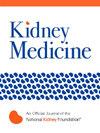Socioeconomic Disadvantage, All-Cause and Cause-Specific Mortality in Patients Treated With Maintenance Dialysis: A Mediation Analysis of Geographical Inequity and Multimorbidity
IF 3.4
Q1 UROLOGY & NEPHROLOGY
引用次数: 0
Abstract
Rationale & Objective
Social gradient in health (a “social gradient in health” refers to the observed pattern in which individuals with lower socioeconomic status typically experience poorer health outcomes than those with higher socioeconomic status. This indicates that health disparities exist across different social levels, with the most disadvantaged groups experiencing the worst health outcomes) is significant and established in patients with kidney failure, but the pathways of this relationship are unknown. We aimed to assess the mediating effects of multimorbidity and geographical remoteness in the socioeconomic status (SES)-death associations.
Study Design
A cohort study.
Setting & Participants
All patients with kidney failure aged 18 years and above, who commenced dialysis in Australia from 2005 to 2019.
Exposure
Area-level SES.
Outcomes
All-cause and cause-specific death.
Analytical Approach
The effect of SES on all-cause and cause-specific death was analyzed using the inverse probability stabilized weighting. Mediating effects of geographical remoteness, diabetes mellitus (DM) and cardiovascular disease (CVD) on the association between lower SES and all-cause and cause-specific death were explored.
Results
A total of 35,239 patients receiving incident dialysis were included, with a median (p25, p75) follow-up period of 3.3 (1.7-5.9) years. Compared with patients from higher SES, the average hazard rate for all-cause death among those from lower SES was 17% higher (total effect [TE] = 0.17, 95% CI [0.12-0.23]). Proportions of the effects between SES and all-cause mortality mediated by geographical remoteness, CVD, and DM were 29.4%, 11.8%, 17.6%, respectively, whereas SES explained 41.2% of the TE directly. Compared with patients from high SES, patients from lower SES have on average a higher hazard rate of CVD (TE = 0.26, 95% CI, [0.15-0.38]) and infection-related deaths (TE = 0.12, 95% CI, [0-0.25]). The effects of SES on CVD and infection-related deaths were mediated by CVD and DM, but not geographical remoteness.
Limitations
Potential residual confounding and other latent mediators.
Conclusions
Geographical remoteness, diabetes, and CVD are potential mediators that lie in the pathways between SES and all-cause and cause-specific deaths. A multifaceted approach with sustained efforts from multiple sectors to address these factors may reduce the social disparities observed in patients treated with dialysis.
Plain-Language Summary
People with kidney failure who have less money or support often have more health problems than those who are better off. In this study, we found that this is not just because of their financial situation, but also because many also have other health problems, including diabetes and heart disease, and they may live in remote areas where it may be harder to access health care and specialist appointments. Our study suggests that we need to provide more support to these people and make sure everyone with kidney failure has a fair chance at good health, no matter where they live or how much money they have.
社会经济劣势、维持性透析患者的全因和特异性死亡率:地理不平等和多发病的中介分析
基本原理和目的健康方面的社会梯度(“健康方面的社会梯度”指的是观察到的一种模式,即社会经济地位较低的个体通常比社会经济地位较高的个体健康状况较差。这表明,健康差异存在于不同的社会阶层(最弱势群体的健康结果最差),这在肾衰竭患者中是显著的,但这种关系的途径尚不清楚。我们的目的是评估多病和地理偏远在社会经济地位(SES)-死亡关联中的中介作用。研究设计:队列研究。参与者:2005年至2019年在澳大利亚开始透析的18岁及以上肾衰竭患者。ExposureArea-level SES。结果:全因死亡和特定原因死亡。分析方法采用逆概率稳定加权法分析SES对全因死亡和特异性死亡的影响。探讨地理偏远、糖尿病(DM)和心血管疾病(CVD)在低社会经济地位与全因死亡和原因特异性死亡之间的中介作用。结果共纳入35239例接受偶发性透析的患者,中位随访时间(p25, p75)为3.3(1.7-5.9)年。与社会地位较高的患者相比,社会地位较低的患者全因死亡的平均危险率高出17%(总效应[TE] = 0.17, 95% CI[0.12-0.23])。地理位置偏远、心血管疾病和糖尿病介导的SES和全因死亡率之间的影响比例分别为29.4%、11.8%和17.6%,而SES直接解释了41.2%的TE。与高经济地位的患者相比,低经济地位的患者心血管疾病(TE = 0.26, 95% CI,[0.15-0.38])和感染相关死亡(TE = 0.12, 95% CI,[0-0.25])的平均危险率更高。SES对CVD和感染相关死亡的影响是由CVD和DM介导的,但与地理位置无关。潜在的残留混淆和其他潜在的介质。结论地理位置偏远、糖尿病和心血管疾病是SES与全因死亡和病因特异性死亡之间的潜在中介因素。多部门持续努力解决这些因素的多方面方法可能会减少透析治疗患者中观察到的社会差异。肾衰竭的人如果没有足够的钱或支持,通常会比那些生活富裕的人有更多的健康问题。在这项研究中,我们发现这不仅仅是因为他们的经济状况,还因为许多人还有其他健康问题,包括糖尿病和心脏病,而且他们可能生活在偏远地区,在那里可能更难获得医疗保健和专家预约。我们的研究表明,我们需要为这些人提供更多的支持,确保每个肾衰竭患者都有公平的机会保持健康,无论他们住在哪里,也不管他们有多少钱。
本文章由计算机程序翻译,如有差异,请以英文原文为准。
求助全文
约1分钟内获得全文
求助全文

 求助内容:
求助内容: 应助结果提醒方式:
应助结果提醒方式:


